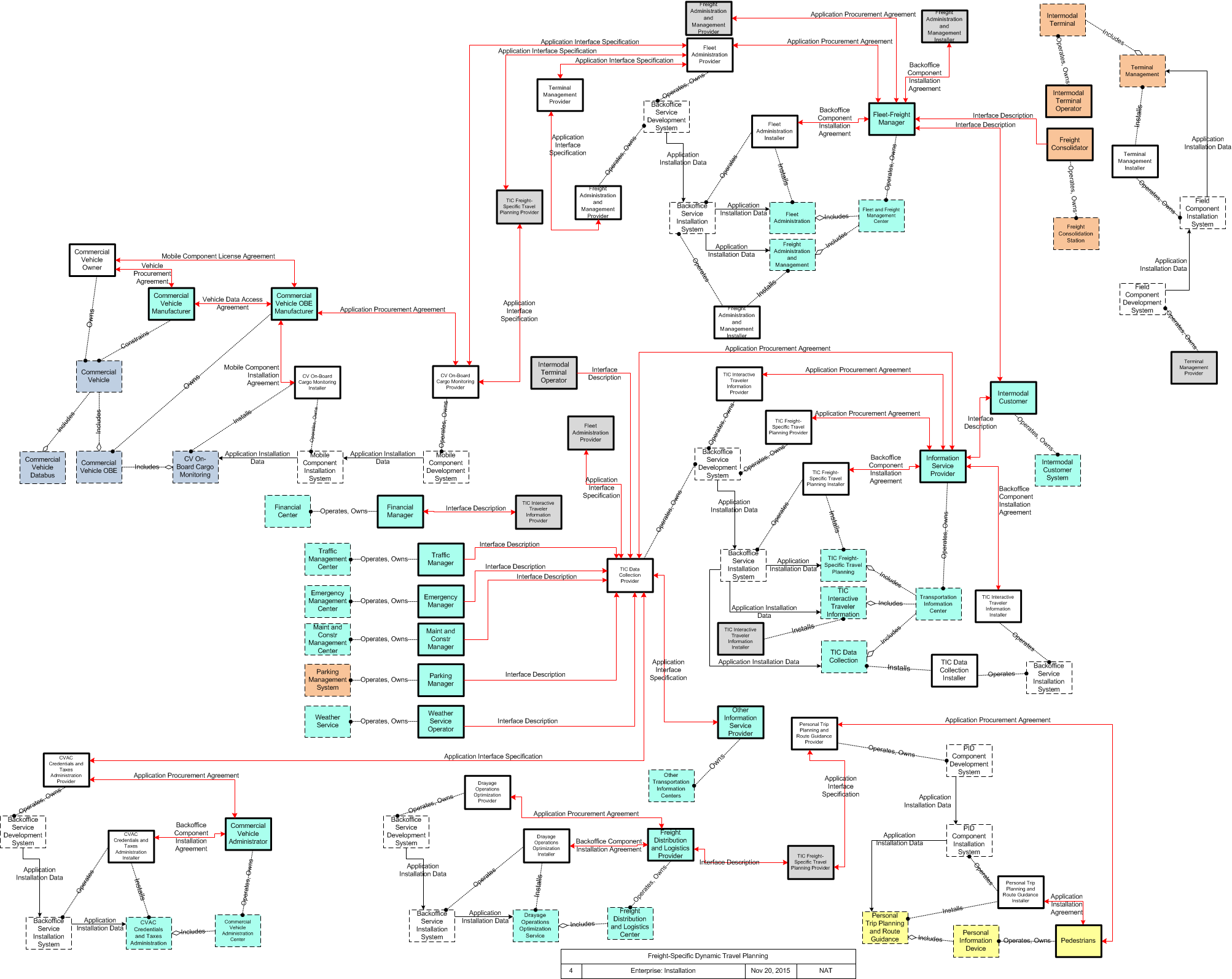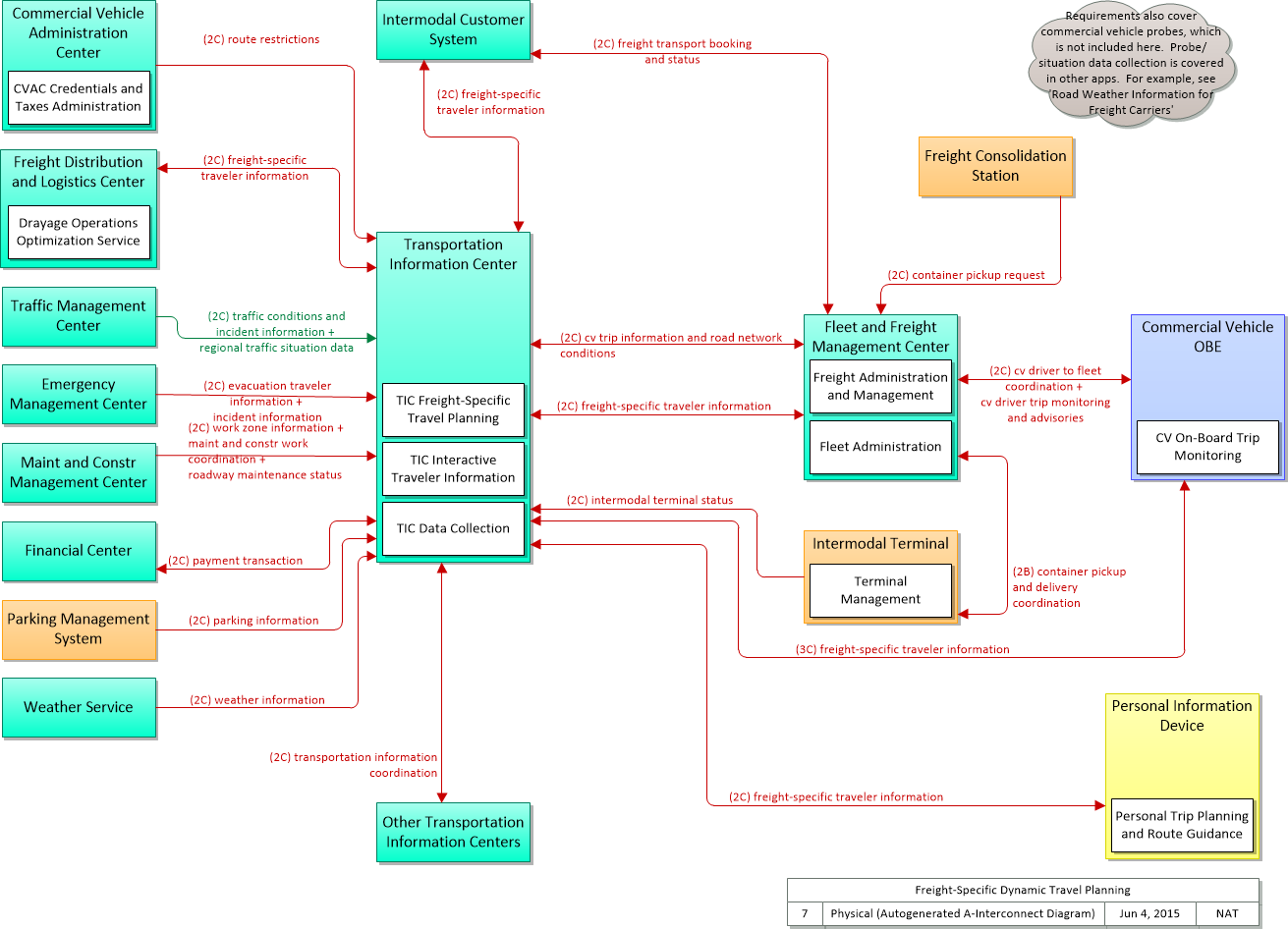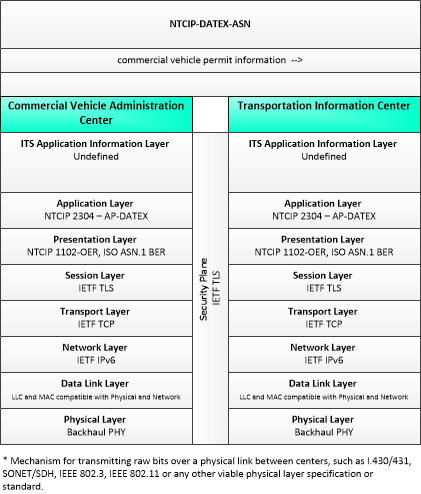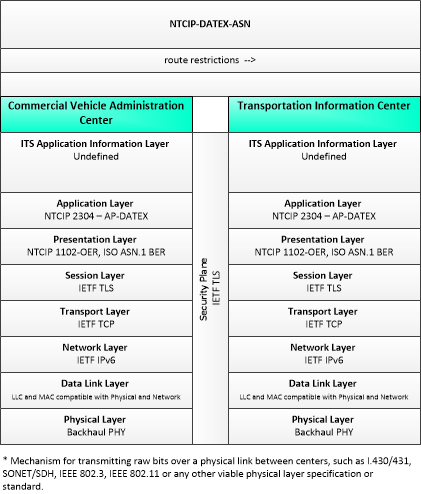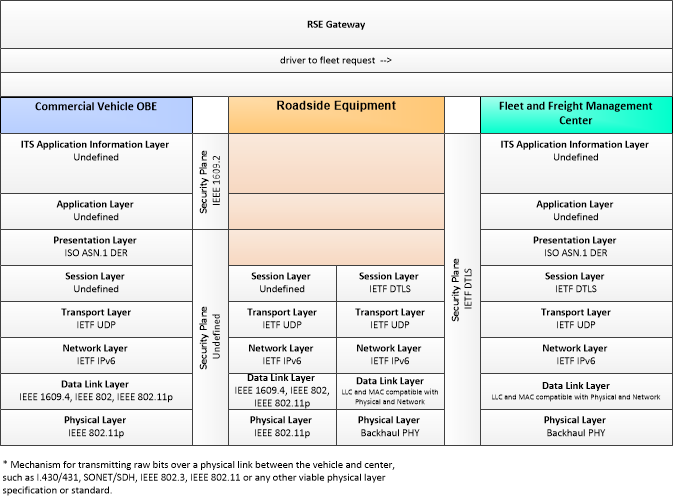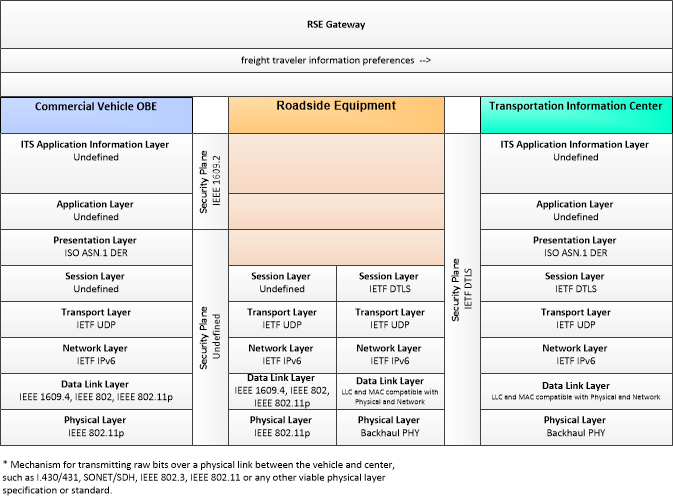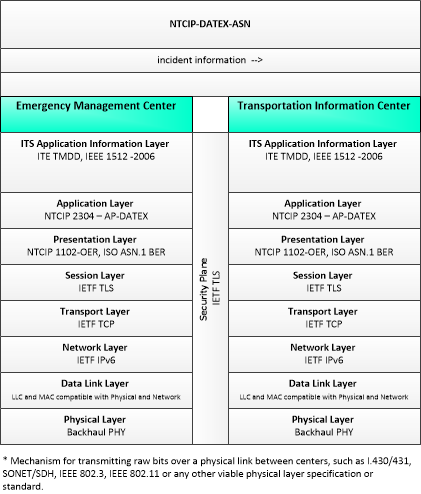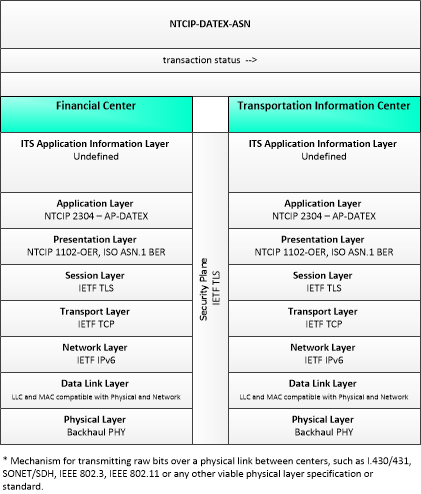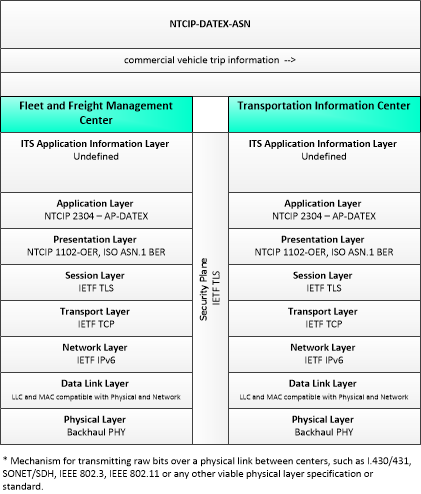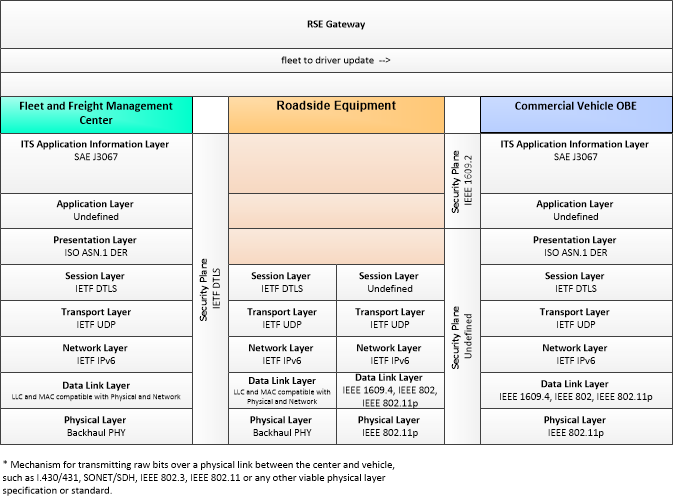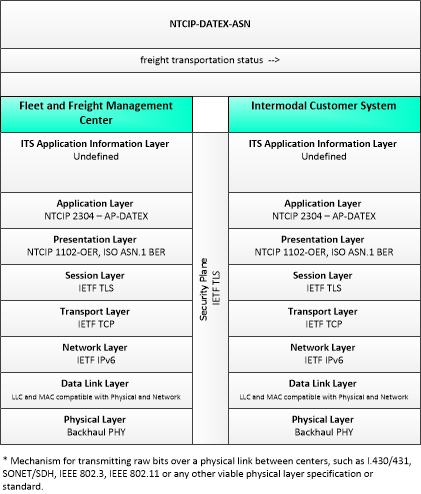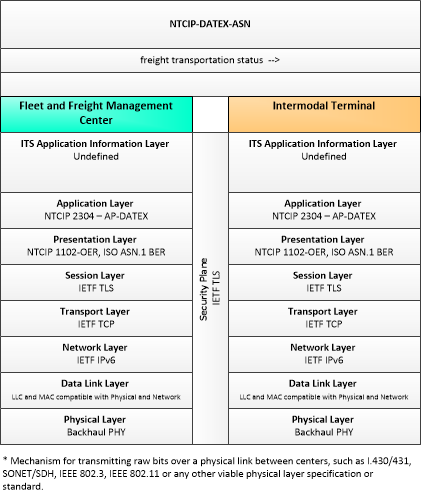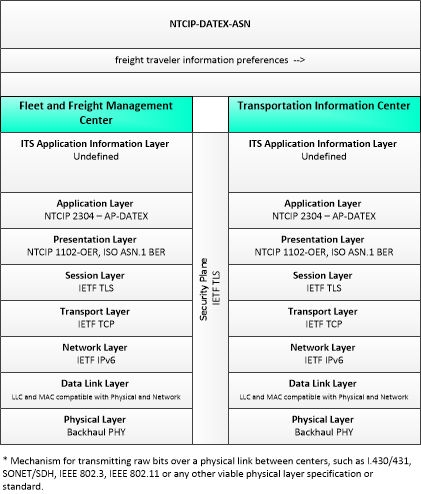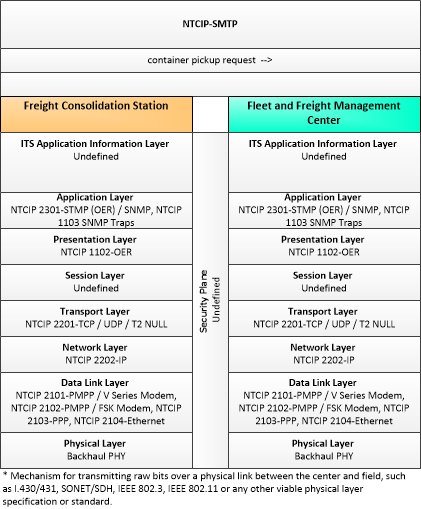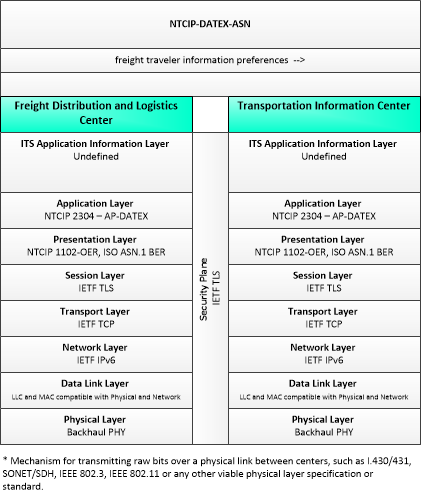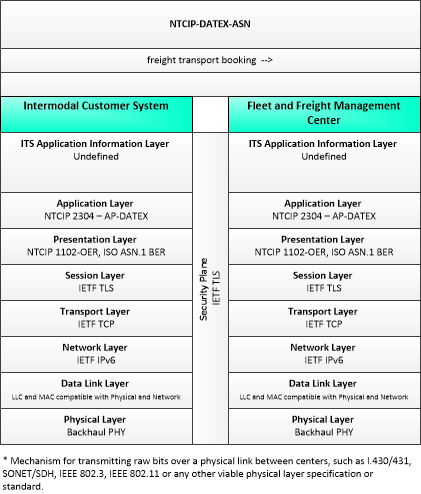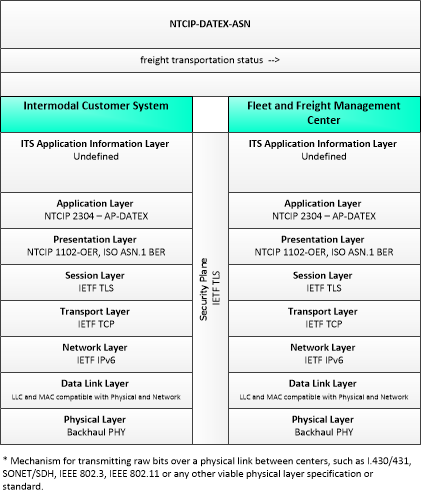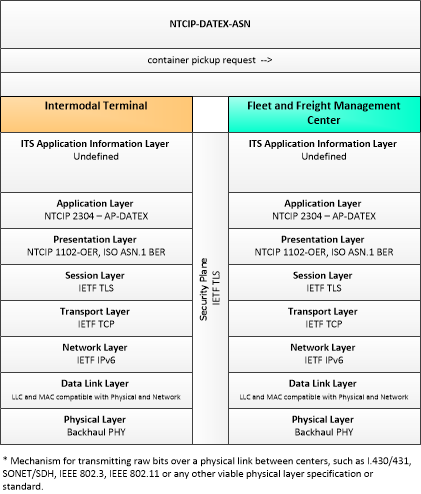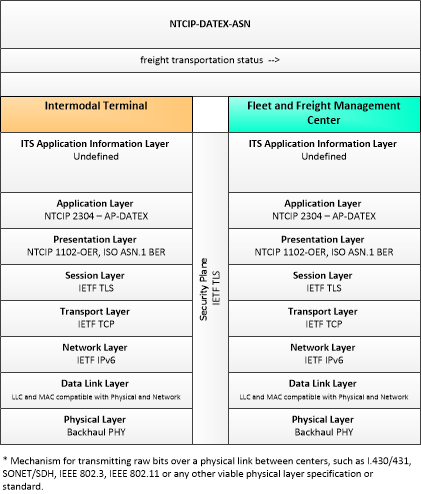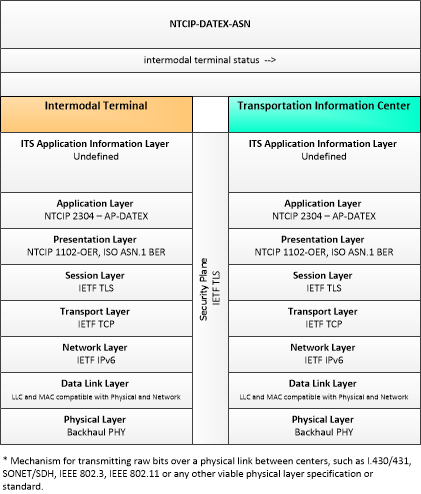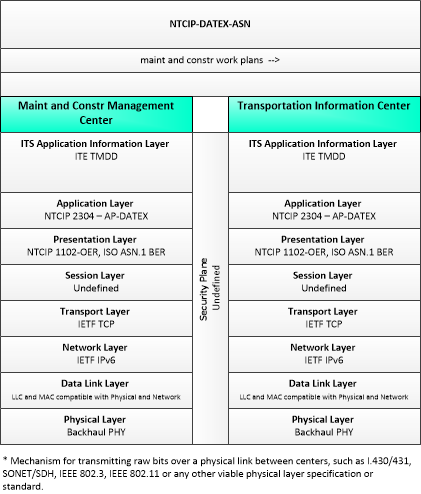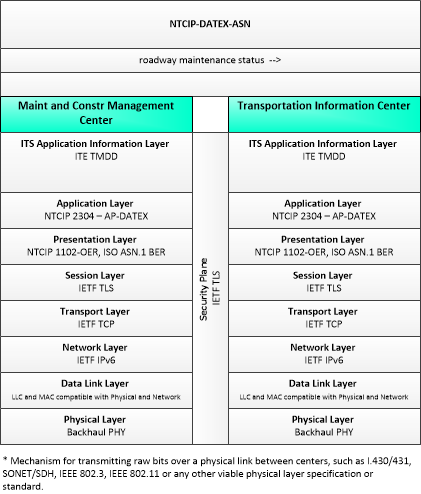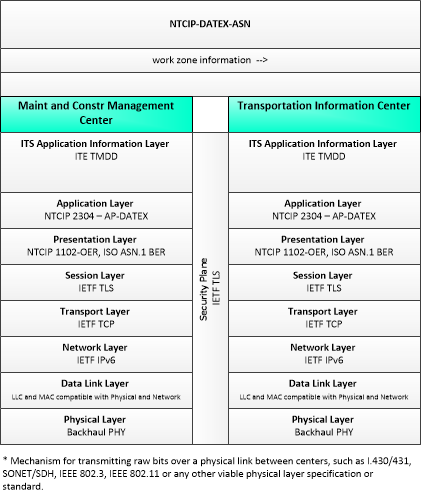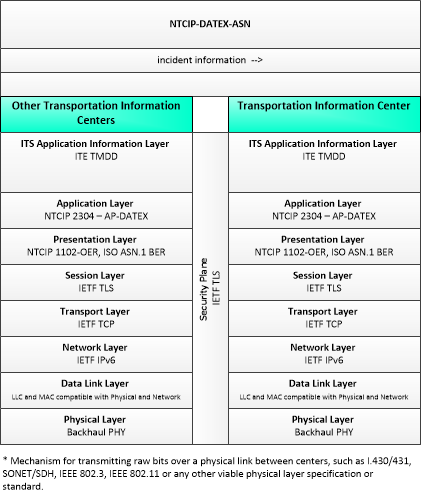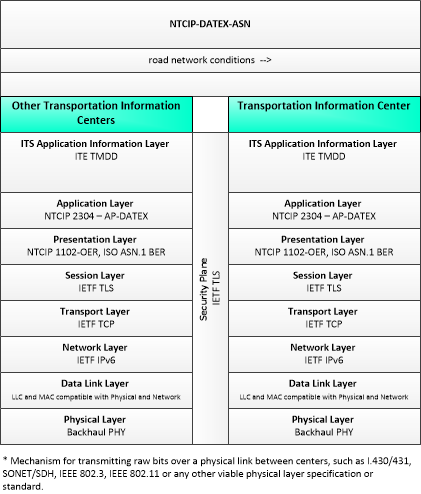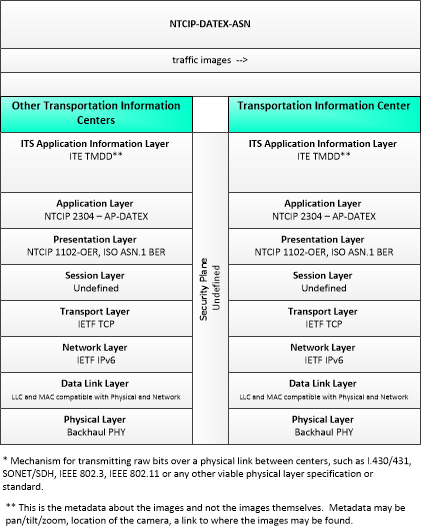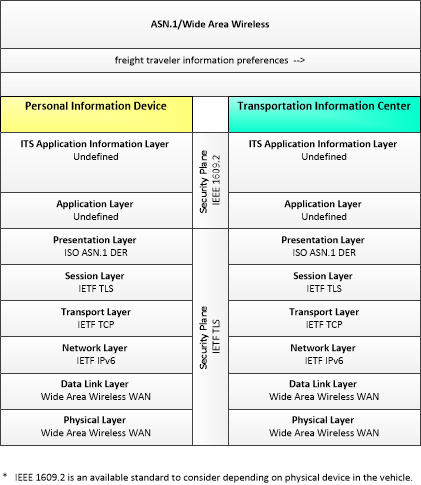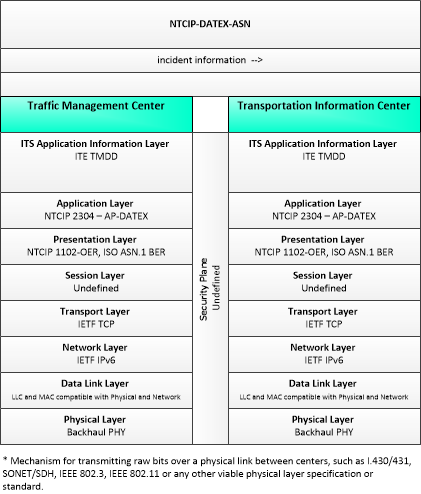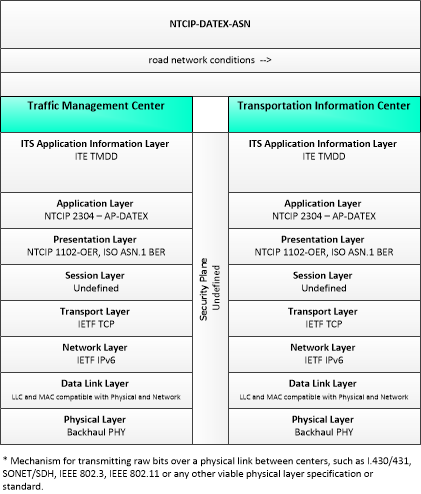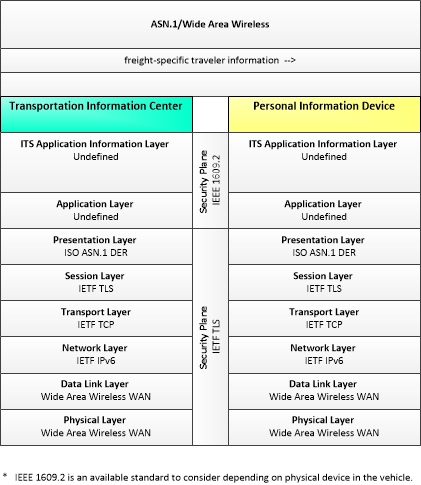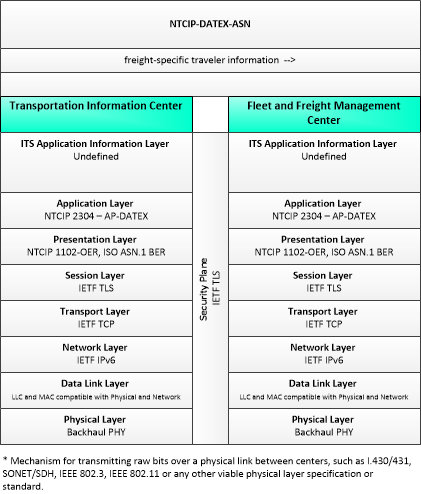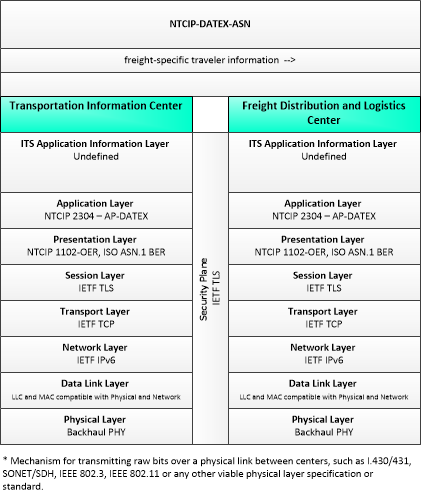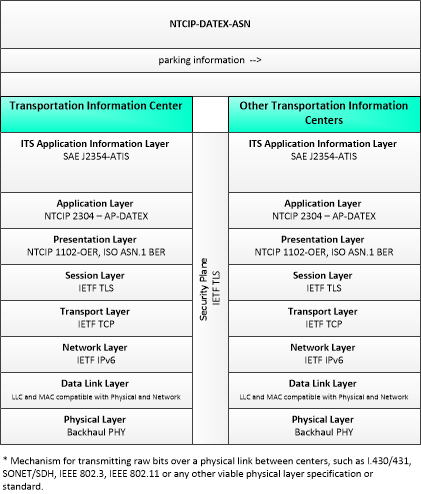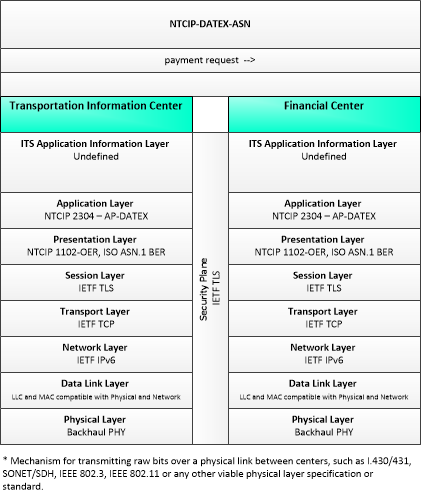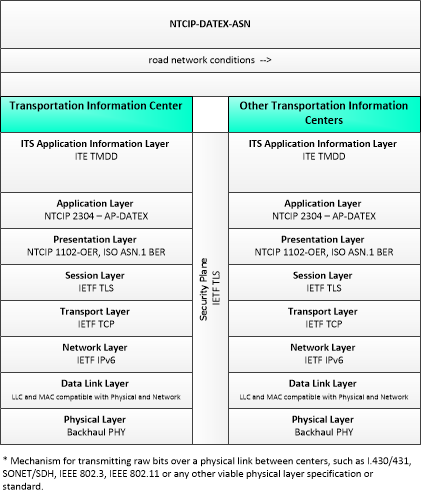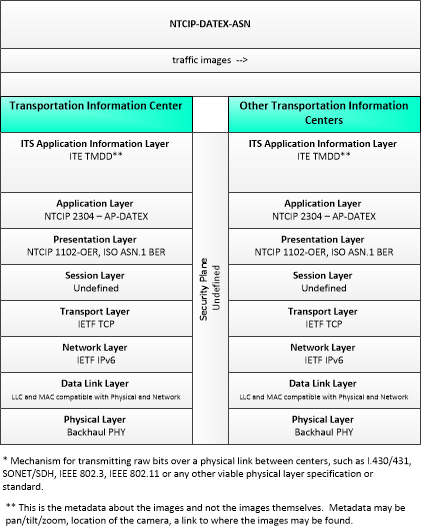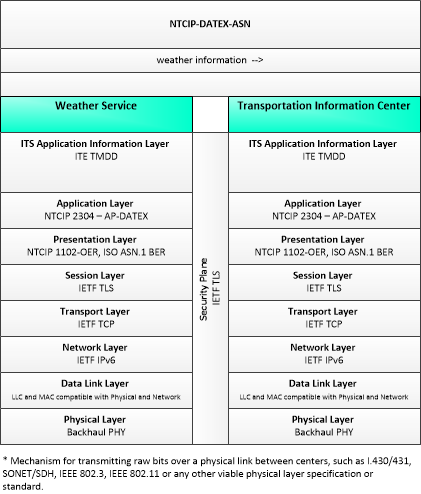Type: Mobility
Groups:- Freight Advanced Traveler Information Systems
Freight-Specific Dynamic Travel Planning
The Freight-Specific Dynamic Travel Planning application provides both pretrip and enroute travel planning, routing, and commercial vehicle related traveler information, which includes information such as truck parking locations and current status. The information will be based on data collected from the commercial fleet as well as general traffic data collection capabilities. The information, both real time and static can be provided directly to fleet managers, to mobile devices used by commercial vehicle operators, or directly to in vehicle systems as commercial vehicles approach roadway exits with key facilities such as parking. The application can also provide oversize/ overweight permit information to commercial managers.
Enterprise
SVG Diagrams: Installation Operations Maintenance Certification
PNG Diagrams: Installation Operations Maintenance Certification

Business Interaction Matrix:
| Freight-Specific Dynamic Travel Planning Operations Stage | ||||||||||||||||||
|---|---|---|---|---|---|---|---|---|---|---|---|---|---|---|---|---|---|---|
| Fleet-Freight Manager | Freight Distribution and Logistics Provider | Intermodal Terminal Operator | Commercial Vehicle Owner | Commercial Vehicle Driver | Intermodal Customer | Traffic Manager | Information Service Provider | Weather Service Operator | Maint and Constr Manager | Emergency Manager | Financial Manager | Parking Manager | Commercial Vehicle Administrator | Other Information Service Provider | Freight Consolidator | Personal Trip Planning and Route Guidance Provider | CV On-Board Cargo Monitoring Provider | |
| Fleet-Freight Manager | Information Exchange Agreement | Information Exchange Agreement | Information Exchange Agreement | Information Exchange and Action Agreement | Information Provision Agreement | |||||||||||||
| Freight Distribution and Logistics Provider | Information Exchange Agreement | |||||||||||||||||
| Intermodal Terminal Operator | Information Exchange Agreement | |||||||||||||||||
| Commercial Vehicle Owner | Information Exchange Agreement | Vehicle Operating Agreement | Information Exchange Agreement | Application Usage Agreement | ||||||||||||||
| Commercial Vehicle Driver | Vehicle Operating Agreement | Information Exchange Agreement | Application Usage Agreement | |||||||||||||||
| Intermodal Customer | Information Exchange Agreement | Information Exchange and Action Agreement | ||||||||||||||||
| Traffic Manager | Information Provision Agreement | |||||||||||||||||
| Information Service Provider | Information Exchange and Action Agreement | Information Exchange Agreement | Information Exchange Agreement | Information Exchange Agreement | Information Exchange and Action Agreement | Information Provision Agreement | Information Provision Agreement | Information Provision Agreement | Information Provision Agreement | Information Exchange and Action Agreement | Information Provision Agreement | Information Provision Agreement | Information Exchange Agreement | |||||
| Weather Service Operator | Information Provision Agreement | |||||||||||||||||
| Maint and Constr Manager | Information Provision Agreement | |||||||||||||||||
| Emergency Manager | Information Provision Agreement | |||||||||||||||||
| Financial Manager | Information Exchange and Action Agreement | |||||||||||||||||
| Parking Manager | Information Provision Agreement | |||||||||||||||||
| Commercial Vehicle Administrator | Information Provision Agreement | |||||||||||||||||
| Other Information Service Provider | Information Exchange Agreement | |||||||||||||||||
| Freight Consolidator | Information Provision Agreement | |||||||||||||||||
| Personal Trip Planning and Route Guidance Provider | Application Usage Agreement | |||||||||||||||||
| CV On-Board Cargo Monitoring Provider | Application Usage Agreement | |||||||||||||||||
Includes Enterprise Objects:
| Enterprise Object | Description |
|---|---|
| Application Certification Entity | The body that determines whether an application may be deployed and operated in the Connected Vehicle Environment. This entity's composition, the requirements it applies and the procedures it uses to verify those requirements may vary with application type. For example, applications with human safety component (crash avoidance, movement assistance etc.) may have stringent requirements and extensive testing in a variety of conditions, while applications that provide strictly mobility functionality may have far less testing requirements; possibly as little as just making sure the application doesn't interfere with any other applications. |
| Commercial Vehicle Administrator | The organization responsible for the administration functions performed by the Commercial Vehicle Administration Center. |
| Commercial Vehicle Driver | The 'Commercial Vehicle Driver' represents the people that operate vehicles transporting goods, including both long haul trucks and local pick-up and delivery vans. This physical object is complementary to the Driver physical object in that it represents those interactions which are unique to Commercial Vehicle Operations. Information flowing from the Commercial Vehicle Driver includes those system inputs specific to Commercial Vehicle Operations. |
| Commercial Vehicle Manufacturer | The entity which builds commercial vehicles, including long haul trucks and local pick up and delivery vehicles. This entity is complementary to the Vehicle Manufacturer entity in that it represents those aspects of vehicle manufacture which are unique to commercial vehicles. |
| Commercial Vehicle OBE Manufacturer | The Commercial Vehicle OBE Manufacturer is the provider of the commercial vehicle on-board equipment. This entity may design and build the OBE, or may integrate other components to form the OBE, or may use some combination of approaches to provide the on-board equipment. Since the OBE could be aftermarket, retrofit, built-in or nomadic, this entity is the one that builds whatever that-is. In some cases it may be a smart phone manufacturer, or in others a top tier parts supplier, or any other entity in the production chain, depending on the device and commercial vehicle in question. |
| Commercial Vehicle Owner | The entity that owns the commercial vehicle. This entity is complementary to the Vehicle Owner in that it represents those aspects of ownership which are unique to commercial vehicles. |
| CV On-Board Cargo Monitoring Installer | Application Component Installers are specified more by role than by function. Installers are responsible for the installation of the application component, which may require a support system, and may entail agreements and relationships between end users and application providers. |
| CV On-Board Cargo Monitoring Maintainer | Application Component Maintainers are specified more by role than by function. Maintainers are responsible for the maintenance (configuration changes, patches and updates, hardware repairs) of the application component, which may require a support system, and may entail agreements and relationships between end users and application providers. |
| CV On-Board Cargo Monitoring Provider | Application Component Providers are specified more by role than by function. Providers are responsible for the development of the application component, including initial creation, enhancement and bug fixes. Delivery of the application to the end user may require relationships with other entities (installers, maintainers) if the provider chooses not to fulfill those roles. |
| CVAC Credentials and Taxes Administration Installer | Application Component Installers are specified more by role than by function. Installers are responsible for the installation of the application component, which may require a support system, and may entail agreements and relationships between end users and application providers. |
| CVAC Credentials and Taxes Administration Maintainer | Application Component Maintainers are specified more by role than by function. Maintainers are responsible for the maintenance (configuration changes, patches and updates, hardware repairs) of the application component, which may require a support system, and may entail agreements and relationships between end users and application providers. |
| CVAC Credentials and Taxes Administration Provider | Application Component Providers are specified more by role than by function. Providers are responsible for the development of the application component, including initial creation, enhancement and bug fixes. Delivery of the application to the end user may require relationships with other entities (installers, maintainers) if the provider chooses not to fulfill those roles. |
| Device Certification Entity | The body that determines whether a device may be deployed and operated in the Connected Vehicle Environment. This entity's composition, the requirements it applies and the procedures it uses to verify those requirements may vary with device type. |
| Drayage Operations Optimization Installer | Application Component Installers are specified more by role than by function. Installers are responsible for the installation of the application component, which may require a support system, and may entail agreements and relationships between end users and application providers. |
| Drayage Operations Optimization Maintainer | Application Component Maintainers are specified more by role than by function. Maintainers are responsible for the maintenance (configuration changes, patches and updates, hardware repairs) of the application component, which may require a support system, and may entail agreements and relationships between end users and application providers. |
| Drayage Operations Optimization Provider | Application Component Providers are specified more by role than by function. Providers are responsible for the development of the application component, including initial creation, enhancement and bug fixes. Delivery of the application to the end user may require relationships with other entities (installers, maintainers) if the provider chooses not to fulfill those roles. |
| Emergency Manager | The "Emergency Manager" represents agencies charged with incident management, disaster response, and transportation environment security. |
| Federal Regulatory | Federal regulatory bodies that have legal authority to control and/or provide input to policies regulating transportation infrastructure and operations. This includes entities such as the Federal Communications Commission and US Department of Transportation. |
| Financial Manager | The organization that accepts and processes payment requests and other funds transfers through the Financial Center. |
| Fleet Administration Installer | Application Component Installers are specified more by role than by function. Installers are responsible for the installation of the application component, which may require a support system, and may entail agreements and relationships between end users and application providers. |
| Fleet Administration Maintainer | Application Component Maintainers are specified more by role than by function. Maintainers are responsible for the maintenance (configuration changes, patches and updates, hardware repairs) of the application component, which may require a support system, and may entail agreements and relationships between end users and application providers. |
| Fleet Administration Provider | Application Component Providers are specified more by role than by function. Providers are responsible for the development of the application component, including initial creation, enhancement and bug fixes. Delivery of the application to the end user may require relationships with other entities (installers, maintainers) if the provider chooses not to fulfill those roles. |
| Fleet-Freight Manager | The 'Fleet-Freight Manager' represents the people that are responsible for the dispatching and management of Commercial Vehicle fleets (e.g. traditional Fleet Managers) and Freight Equipment assets. It may be many people in a large tracking organization or a single person (owner driver) in the case of single vehicle fleets. The Fleet-Freight Manager provides instructions and coordination for Commercial Vehicles and Freight Equipment and receives the status of the vehicles and freight equipment in the fleet that they manage. |
| Freight Administration and Management Installer | Application Component Installers are specified more by role than by function. Installers are responsible for the installation of the application component, which may require a support system, and may entail agreements and relationships between end users and application providers. |
| Freight Administration and Management Maintainer | Application Component Maintainers are specified more by role than by function. Maintainers are responsible for the maintenance (configuration changes, patches and updates, hardware repairs) of the application component, which may require a support system, and may entail agreements and relationships between end users and application providers. |
| Freight Administration and Management Provider | The developer and distributor of center systems that monitor and track the movement of freight containers, facilitates intermodal transfers and border crossings. |
| Freight Consolidator | The entity responsible for freight consolidation activities. |
| Freight Distribution and Logistics Provider | The owner and operator of the Freight Distribution and Logistics Center, ultimately responsible for the functionality that center provides. |
| Information Service Provider | The "Information Service Provider" represents the owner of the Transportation Information Center. The Information Service Provider is responsible for collecting and disseminating information relevant to the traveling public. |
| Intermodal Customer | The "Intermodal Customer" represents organizations that engage in the shipment of freight, either originator (consigner or shipper) or recipient of the cargo shipment. They enable ITS to move goods on routes that require the use of other modes of transportation such as heavy rail, air, sea, etc. This physical object interfaces with Fleet-Freight Managers to transfer cargo from one mode to another. This definition includes those responsible for the movement of freight across international borders. |
| Intermodal Terminal Operator | The entity that operates the intermodal terminal, the point of exchange where freight is moved from one mode to another. |
| ITS Certification Entity | The body that determines whether an ITS device or application may be deployed and operated in the transportation environment. This entity's composition, the requirements it applies and the procedures it uses to verify those requirements may vary with device and application type. Typically not a formal body, assigned on a project-by-project basis depending on the type of infrastructure involved. Since ITS projects are locally-focused (typically state or smaller), the entities that are part of this body are typically those with operational jurisdiction where the ITS is installed (e.g., state or local DOTs, state or local maintenance managers etc.) |
| Maint and Constr Manager | The organization responsible for maintenance and construction activities. |
| Other Information Service Provider | Representing another Information Service Provider, "Other Information Service Provider" provides the source and destination for agreements and expectations between Information Service Providers, enabling information management activities to be coordinated across jurisdictional boundaries. |
| Parking Manager | The organization that manages parking facilities, including lots, access control, parking meters. |
| Pedestrians | 'Pedestrians' participate in connected vehicle applications that support safe, shared use of the transportation network by motorized and non-motorized transportation modes. Representing those using non-motorized travel modes, pedestrians provide input (e.g. a call signal requesting right of way at an intersection) and may be detected by connected vehicle applications to improve safety. Note that pedestrians represent all non-motorized users, including bicyclists. |
| Personal Trip Planning and Route Guidance Installer | Application Component Installers are specified more by role than by function. Installers are responsible for the installation of the application component, which may require a support system, and may entail agreements and relationships between end users and application providers. |
| Personal Trip Planning and Route Guidance Maintainer | Application Component Maintainers are specified more by role than by function. Maintainers are responsible for the maintenance (configuration changes, patches and updates, hardware repairs) of the application component, which may require a support system, and may entail agreements and relationships between end users and application providers. |
| Personal Trip Planning and Route Guidance Provider | Application Component Providers are specified more by role than by function. Providers are responsible for the development of the application component, including initial creation, enhancement and bug fixes. Delivery of the application to the end user may require relationships with other entities (installers, maintainers) if the provider chooses not to fulfill those roles. |
| PID Provider | The entity that designs, manufacturers and provides (either to the end user or to a reseller) the personal information device, including its hardware and base operating software. |
| State Regulatory | State regulatory bodies that have legal authority to control and/or provide input to policies regulating vehicles, transportation infrastructure and operations. This includes entities like Departments of Motor Vehicles, property tax authorities and tolling agencies. |
| Terminal Management Installer | Application Component Installers are specified more by role than by function. Installers are responsible for the installation of the application component, which may require a support system, and may entail agreements and relationships between end users and application providers. |
| Terminal Management Maintainer | Application Component Maintainers are specified more by role than by function. Maintainers are responsible for the maintenance (configuration changes, patches and updates, hardware repairs) of the application component, which may require a support system, and may entail agreements and relationships between end users and application providers. |
| Terminal Management Provider | Application Component Providers are specified more by role than by function. Providers are responsible for the development of the application component, including initial creation, enhancement and bug fixes. Delivery of the application to the end user may require relationships with other entities (installers, maintainers) if the provider chooses not to fulfill those roles. |
| TIC Data Collection Installer | Application Component Installers are specified more by role than by function. Installers are responsible for the installation of the application component, which may require a support system, and may entail agreements and relationships between end users and application providers. |
| TIC Data Collection Maintainer | Application Component Maintainers are specified more by role than by function. Maintainers are responsible for the maintenance (configuration changes, patches and updates, hardware repairs) of the application component, which may require a support system, and may entail agreements and relationships between end users and application providers. |
| TIC Data Collection Provider | Application Component Providers are specified more by role than by function. Providers are responsible for the development of the application component, including initial creation, enhancement and bug fixes. Delivery of the application to the end user may require relationships with other entities (installers, maintainers) if the provider chooses not to fulfill those roles. |
| TIC Freight-Specific Travel Planning Installer | Application Component Installers are specified more by role than by function. Installers are responsible for the installation of the application component, which may require a support system, and may entail agreements and relationships between end users and application providers. |
| TIC Freight-Specific Travel Planning Maintainer | Application Component Maintainers are specified more by role than by function. Maintainers are responsible for the maintenance (configuration changes, patches and updates, hardware repairs) of the application component, which may require a support system, and may entail agreements and relationships between end users and application providers. |
| TIC Freight-Specific Travel Planning Provider | Application Component Providers are specified more by role than by function. Providers are responsible for the development of the application component, including initial creation, enhancement and bug fixes. Delivery of the application to the end user may require relationships with other entities (installers, maintainers) if the provider chooses not to fulfill those roles. |
| TIC Interactive Traveler Information Installer | Application Component Installers are specified more by role than by function. Installers are responsible for the installation of the application component, which may require a support system, and may entail agreements and relationships between end users and application providers. |
| TIC Interactive Traveler Information Maintainer | Application Component Maintainers are specified more by role than by function. Maintainers are responsible for the maintenance (configuration changes, patches and updates, hardware repairs) of the application component, which may require a support system, and may entail agreements and relationships between end users and application providers. |
| TIC Interactive Traveler Information Provider | Application Component Providers are specified more by role than by function. Providers are responsible for the development of the application component, including initial creation, enhancement and bug fixes. Delivery of the application to the end user may require relationships with other entities (installers, maintainers) if the provider chooses not to fulfill those roles. |
| Traffic Manager | The entity responsible for the management of traffic, both freeway and arterial. |
| Weather Service Operator | The human operator of systems that provide weather, hydrologic and climate information, and warnings of hazardous weather and climate events. |
Includes Resources:
| Resource | Description |
|---|---|
| Application Component Certification Requirements | The requirements that define the functionality, performance and operational environment of an application component. Certification Requirements must be met in order for an application to be installed in the CVE. |
| Backoffice Service Development System | The systems used to develop backoffice (center) hardware and software components of applications. |
| Backoffice Service Installation System | The systems used to install and configure backoffice (center) hardware and software components. |
| Backoffice Service Maintenance System | The systems used to maintain and upgrade backoffice (center) hardware and software components. |
| Commercial Vehicle | The commercial vehicle includes the sensory, processing, storage, and communications functions necessary to support safe and efficient commercial vehicle operations. It includes two-way communications between the commercial vehicle drivers, their fleet managers, attached freight equipment, and roadside officials, and provides HAZMAT response teams with timely and accurate cargo contents information after a vehicle incident. It can collect and process vehicle, cargo information from the attached freight equipment, and driver safety data and status and alert the driver whenever there is a potential safety or security problem. Basic identification, security and safety status data are supplied to inspection facilities at mainline speeds. In addition, it can automatically collect and record mileage, fuel usage, and border crossings. |
| Commercial Vehicle Administration Center | The 'Commercial Vehicle Administration Center' performs administrative functions supporting credentials, tax, and safety regulations associated with commercial vehicles. It issues credentials, collects fees and taxes, and supports enforcement of credential requirements. It communicates with motor carriers to process credentials applications and collect fuel taxes, weight/distance taxes, and other taxes and fees associated with commercial vehicle operations. It also receives applications for, and issues special Oversize/Overweight and HAZMAT permits in coordination with cognizant authorities. It coordinates with other Commercial Vehicle Administration Centers (in other states/regions) to support nationwide access to credentials and safety information for administration and enforcement functions. It communicates with field equipment to enable credential checking and safety information collection at the roadside. It makes safety information available to qualified stakeholders to identify carriers and drivers that operate unsafely. |
| Commercial Vehicle Databus | The 'Commercial Vehicle Databus' represents the interface to the heavy vehicle databus that connects on-board systems included in the commercial vehicle. This vehicle is used to transport goods, is operated by a professional driver and typically administered as part of a larger fleet. Commercial Vehicle classification applies to all goods transport vehicles ranging from small panel vans used in local pick-up and delivery services to large, multi-axle tractor-trailer rigs operating on long haul routes. It is a specialized and extended form of the Vehicle Databus that may be subject to different vehicle databus standards and connect with a broad range of components that are specific to commercial vehicles including the systems that are used to monitor, secure, and maintain freight while enroute. As a specialized form of the Vehicle Databus, it also provides access to the general-purpose sensors (e.g., radars, cameras), GPS, drive train monitoring and control systems, and vehicle safety features that support connected vehicle applications. |
| Commercial Vehicle OBE | The Commercial Vehicle On-Board Equipment (OBE) resides in a commercial vehicle and provides the sensory, processing, storage, and communications functions necessary to support safe and efficient commercial vehicle operations. It provides two-way communications between the commercial vehicle drivers, their fleet managers, attached freight equipment, and roadside officials. In CVRIA, a separate 'Vehicle OBE' physical object supports the general V2V and V2I safety applications and other applications that apply to all vehicles, including commercial vehicles. The Commercial Vehicle OBE supplements these general capabilities with capabilities that are specific to commercial vehicles. |
| CV On-Board Cargo Monitoring | "CV On-Board Cargo Monitoring" monitors the location and status of the commercial vehicle and its cargo. It sends the collected data to appropriate centers and roadside facilities, including emergency management in the case of HAZMAT incidents. Depending on the nature of the cargo, it may include sensors that measure temperature, pressure, load leveling, acceleration, and other attributes of the cargo. |
| CVAC Credentials and Taxes Administration | "CVAC Credentials and Taxes Administration" issues credentials, collects fees and taxes, and supports enforcement of credential requirements. It manages driver licensing and enrolls carriers in additional CVO programs such as wireless roadside inspection programs. It communicates with the Fleet and Freight Management Centers associated with the motor carriers to process applications and collect fuel taxes, weight/distance taxes, and other taxes and fees associated with commercial vehicle operations. It also receives applications for, and issues special Oversize/Overweight and HAZMAT permits in coordination with other cognizant authorities. It supports user account management and receives and processes requests for review of carrier and driver status. It communicates with similar packages in other jurisdictions to exchange credentials database information. |
| Device Certification Requirements | The requirements that define the functionality, performance and operational environment of a connected vehicle device. Certification Requirements must be met in order for the device to be granted the credentials necessary to operate in the Connected Vehicle Environment. |
| Drayage Operations Optimization Service | The "Drayage Operations Optimization Service" provides a portal for shippers and receivers to post their loads in need of transport and provide an opportunity for commercial vehicles to find a load to haul on their trip back to/from an intermodal facility. It connects load matching services with container and chassis/equipment availability information and appointment/reservations services from the intermodal terminals to provide an optimized, regionally integrated view of intermodal container transport for drayage operators. |
| Emergency Management Center | The 'Emergency Management Center' represents systems that support incident management, disaster response and evacuation, security monitoring, and other security and public safety-oriented ITS applications. It includes the functions associated with fixed and mobile public safety communications centers including public safety call taker and dispatch centers operated by police (including transit police), fire, and emergency medical services. It includes the functions associated with Emergency Operations Centers that are activated at local, regional, state, and federal levels for emergencies and the portable and transportable systems that support Incident Command System operations at an incident. This Center also represents systems associated with towing and recovery, freeway service patrols, HAZMAT response teams, and mayday service providers. It manages sensor and surveillance equipment used to enhance transportation security of the roadway infrastructure (including bridges, tunnels, interchanges, and other key roadway segments) and the public transportation system (including transit vehicles, public areas such as transit stops and stations, facilities such as transit yards, and transit infrastructure such as rail, bridges, tunnels, or bus guideways). It provides security/surveillance services to improve traveler security in public areas not a part of the public transportation system. It monitors alerts, advisories, and other threat information and prepares for and responds to identified emergencies. It coordinates emergency response involving multiple agencies with peer centers. It stores, coordinates, and utilizes emergency response and evacuation plans to facilitate this coordinated response. Emergency situation information including damage assessments, response status, evacuation information, and resource information are shared The Emergency Management Center also provides a focal point for coordination of the emergency and evacuation information that is provided to the traveling public, including wide-area alerts when immediate public notification is warranted. It tracks and manages emergency vehicle fleets using real-time road network status and routing information from the other centers to aid in selecting the emergency vehicle(s) and routes, and works with other relevant centers to tailor traffic control to support emergency vehicle ingress and egress, implementation of special traffic restrictions and closures, evacuation traffic control plans, and other special strategies that adapt the transportation system to better meet the unique demands of an emergency. |
| Field Component Development System | The system used in a backoffice environment to develop and test the field component of the application. |
| Field Component Installation System | The system used to install a field component of a connected vehicle application. |
| Field Component Maintenance System | The system used to install and configure changes and updates to the field component of the application. This system is capable of acquiring and reporting diagnostic information about the application's configuration and performance. |
| Financial Center | The 'Financial Center' represents the organization that handles electronic fund transfer requests to enable the transfer of funds from the user of the service to the provider of the service. The functions and activities of financial clearinghouses are subsumed by this entity. |
| Fleet Administration | "Fleet Administration" provides vehicle tracking, dispatch, and reporting capabilities to fleet management center personnel. It gathers current road conditions and traffic information, prepares vehicle routes, and provides a fleet interface for toll collection. It also provides route plan information for network performance evaluation. As part of the tracking function, it monitors commercial vehicle location, compares it against the known route and notifies the Emergency Management Center and Fleet-Freight Manager of any deviations, including HAZMAT route restriction violations. It supports carrier participation in wireless roadside inspection programs, monitoring geographic trigger areas and providing current safety data on behalf of the commercial vehicles it manages. It supports pre-hiring checks for potential drivers and monitors the performance of each driver who is hired. It also supports ongoing monitoring of the company's safety performance. |
| Fleet and Freight Management Center | The 'Fleet and Freight Management Center' provides the capability for commercial drivers and fleet-freight managers to receive real-time routing information and access databases containing vehicle and/or freight equipment locations as well as carrier, vehicle, freight equipment and driver information. The 'Fleet and Freight Management Center' also provides the capability for fleet managers to monitor the safety and security of their commercial vehicle drivers and fleet. |
| Freight Administration and Management | "Freight Administration and Management" manages the movement of freight from source to destination. It interfaces to intermodal customers to setup and schedule transportation and coordinates with intermodal terminals and freight consolidation stations to coordinate the shipment. It coordinates with the appropriate government agencies to expedite the movement of trucks, their drivers, and their cargo across international borders. The application monitors the status of the freight and freight equipment (container, trailer, or chassis) and monitors freight location and compares it against the planned route. |
| Freight Consolidation Station | The 'Freight Consolidation Station' is an intermediate point (usually an intermodal terminal located at a port) prior to (or after) container-based shipping, where less-than-container load or less-than-truckload cargoes are consolidated into full container loads (or full containers are disbursed), for cost-effective intermodal shipping. |
| Freight Distribution and Logistics Center | The 'Freight Distribution and Logistics Center' provides intermodal logistics support and support for the efficient distribution of freight across transport systems and modes. This can include consolidation arrangements, warehousing, and consignor-to-consignee intermodal shipping arrangements. These capabilities may be provided as part of intermodal fleet management activities or can be provided by an independent logistics specialist. |
| Intermodal Customer System | The 'Intermodal Customer System' represents organizations that engage in the shipment of freight, either originator (consigner or shipper) or recipient of the cargo shipment. They enable the movement of goods on routes that require the use of other modes of transportation such as heavy rail, air, sea, etc. The Intermodal Customer System includes those personnel responsible for the movement of freight across international borders. |
| Intermodal Terminal | The 'Intermodal Terminal' represents the terminal areas corresponding to modal change points. This includes interfaces between roadway freight transportation and air, rail, and/or water shipping modes. The basic unit of cargo handled by the Intermodal Terminal physical object is the container; less-than-container load handling is typically handled at a different facility (i.e., Freight Consolidation Station). The Intermodal Terminal can include electronic gate control for entrance and exit from the facility, automated guidance of vehicles within the facility, alerting appropriate parties of container arrivals and departures, and inventory and location of temporarily stored containers. |
| ITS Certification Requirements | The requirements that define the functionality, performance and operational environment of an ITS device or ITS application. Applicability varies with jurisdictions, but typically devices and applications must meet pre-defined acceptance criteria prior to usage in the transportation environment. |
| Maint and Constr Management Center | The 'Maint and Constr Management Center' monitors and manages roadway infrastructure construction and maintenance activities. Representing both public agencies and private contractors that provide these functions, this physical object manages fleets of maintenance, construction, or special service vehicles (e.g., snow and ice control equipment). The physical object receives a wide range of status information from these vehicles and performs vehicle dispatch, routing, and resource management for the vehicle fleets and associated equipment. The physical object participates in incident response by deploying maintenance and construction resources to an incident scene, in coordination with other center physical objects. The physical object manages equipment at the roadside, including environmental sensors and automated systems that monitor and mitigate adverse road and surface weather conditions. It manages the repair and maintenance of both non-ITS and ITS equipment including the traffic controllers, detectors, dynamic message signs, signals, and other equipment associated with the roadway infrastructure. Weather information is collected and fused with other data sources and used to support advanced decision support systems. The physical object remotely monitors and manages ITS capabilities in work zones, gathering, storing, and disseminating work zone information to other systems. It manages traffic in the vicinity of the work zone and advises drivers of work zone status (either directly at the roadside or through an interface with the Transportation Information Center or Traffic Management Center physical objects.) Construction and maintenance activities are tracked and coordinated with other systems, improving the quality and accuracy of information available regarding closures and other roadway construction and maintenance activities. |
| Mobile Component Development System | The system used in a backoffice environment to develop and test the mobile component of the application. |
| Mobile Component Installation System | The system that interacts with the Vehicle OBE other mobile device and installs the mobile component of the application. |
| Mobile Component Maintenance System | The system used to configure changes and updates to the mobile component of the application. This system is capable of acquiring and reporting diagnostic information about the application's configuration and performance. |
| Other Transportation Information Centers | Representing another Transportation Information Center, this object is intended to provide a source and destination for ITS information flows between peer information and service provider functions. It enables cooperative information sharing between providers as conditions warrant. |
| Parking Management System | The Parking Management System provides electronic monitoring and management of parking facilities. It supports an I2V link to the Vehicle that allows electronic collection of parking fees and monitors and controls parking meters that support conventional parking fee collection. It also includes the instrumentation, signs, and other infrastructure that monitors parking lot usage and provides local information about parking availability and other general parking information. This portion of the functionality must be located in the parking facility where it can monitor, classify, and share information with customers and their vehicles. It also interfaces with the financial infrastructure and broadly disseminates parking information to other operational centers in the region. Note that the latter functionality may be located in a back office, remote from the parking facility. |
| Personal Information Device | The 'Personal Information Device' provides the capability for travelers to receive formatted traveler information wherever they are. Capabilities include traveler information, trip planning, and route guidance. Frequently a smart phone, the Personal Information Device provides travelers with the capability to receive route planning and other personally focused transportation services from the infrastructure in the field, at home, at work, or while en-route. Personal Information Devices may operate independently or may be linked with connected vehicle on-board equipment. |
| Personal Trip Planning and Route Guidance | "Personal Trip Planning and Route Guidance" provides a personalized trip plan to the traveler. The trip plan is calculated based on preferences and constraints supplied by the traveler and provided to the traveler for confirmation. Coordination may continue during the trip so that the route plan can be modified to account for new information. Many equipment configurations are possible including systems that provide a basic trip plan to the traveler as well as more sophisticated systems that can provide transition by transition guidance to the traveler along a multi-modal route with transfers. Devices represented by this application object include desktop computers at home, work, or at major trip generation sites, plus personal devices such as tablets and smart phones. |
| PID Component Development System | The system used in a backoffice environment to develop and test the PID component of the application. |
| PID Component Installation System | The system used to install the PID component of a connected vehicle application. |
| PID Component Maintenance System | The system used to configure changes and updates to the PID component of the application. This system is capable of acquiring and reporting diagnostic information about the application's configuration and performance. |
| Terminal Management | "Terminal Management" supports the operation of the roadway aspects of an intermodal terminal. The key capabilities include the ability to identify and control vehicle traffic entering and departing the facility, guide vehicles to loading and unloading points, maintain site security and monitor container integrity, provide an interface to Customs as appropriate, and acknowledge container pickup and drop-off. Other capabilities include the ability to track container locations within the facility, manage any other required assets, like truck chassis, and provide reservation services to manage congestion at busy terminals. This application also provides information to support load matching services for drayage operators. |
| TIC Data Collection | "TIC Data Collection" collects transportation-related data from other centers, performs data quality checks on the collected data and then consolidates, verifies, and refines the data and makes it available in a consistent format to applications that support operational data sharing between centers and deliver traveler information to end-users. A broad range of data is collected including traffic and road conditions, transit data, emergency information and advisories, weather data, special event information, traveler services, parking, multimodal data, and toll/pricing data. It also shares data with other transportation information centers. |
| TIC Freight-Specific Travel Planning | "TIC Freight-Specific Travel Planning" provides traveler information and trip planning services for freight routes from source to destination, customized for freight users to indicate truck routes, truck stops, inspection stations, steep grades, etc. |
| TIC Interactive Traveler Information | "TIC Interactive Traveler Information" disseminates personalized traveler information including traffic and road conditions, transit information, maintenance and construction information, multimodal information, event information, and weather information. Tailored information is provided based on the traveler's request in this interactive service. |
| Traffic Management Center | The 'Traffic Management Center' monitors and controls traffic and the road network. It represents centers that manage a broad range of transportation facilities including freeway systems, rural and suburban highway systems, and urban and suburban traffic control systems. It communicates with ITS Roadway Equipment and Connected Vehicle Roadside Equipment (RSE) to monitor and manage traffic flow and monitor the condition of the roadway, surrounding environmental conditions, and field equipment status. It manages traffic and transportation resources to support allied agencies in responding to, and recovering from, incidents ranging from minor traffic incidents through major disasters. |
| Transportation Information Center | The 'Transportation Information Center' collects, processes, stores, and disseminates transportation information to system operators and the traveling public. The physical object can play several different roles in an integrated ITS. In one role, the TIC provides a data collection, fusing, and repackaging function, collecting information from transportation system operators and redistributing this information to other system operators in the region and other TICs. In this information redistribution role, the TIC provides a bridge between the various transportation systems that produce the information and the other TICs and their subscribers that use the information. The second role of a TIC is focused on delivery of traveler information to subscribers and the public at large. Information provided includes basic advisories, traffic and road conditions, transit schedule information, yellow pages information, ride matching information, and parking information. The TIC is commonly implemented as a website or a web-based application service, but it represents any traveler information distribution service. |
| Weather Service | The 'Weather Service' provides weather, hydrologic, and climate information and warnings of hazardous weather including thunderstorms, flooding, hurricanes, tornadoes, winter weather, tsunamis, and climate events. It provides atmospheric weather observations and forecasts that are collected and derived by the National Weather Service, private sector providers, and various research organizations. The interface provides formatted weather data products suitable for on-line processing and integration with other ITS data products as well as Doppler radar images, satellite images, severe storm warnings, and other products that are formatted for presentation to various ITS users. |
Includes Roles:
| Role | Description |
|---|---|
| Certifies | An Enterprise verifies that a target Resource meets relevant performance, functional, environmental and quality requirements. |
| Constrains | A Resource or Enterprise applies requirements, constraints and associated tests to another Resource. |
| Installs | An Enterprise performs the initial delivery, integration and configuration of the target Resource. |
| Maintains | An Enterprise administers the hardware and software that comprise the target Resource. |
| Member | An Enterprise is part of another larger, target Enterprise. |
| Operates | An Enterprise controls the functionality and state of the target Resource. An Enterprise that Operates a resource is considered Responsible. |
| Owns | An Enterprise has financial ownership and control over the Resource. An Enterprise that Owns a resource is considered Accountable. |
Includes Coordination:
| Coordination | Type | Description |
|---|---|---|
| Application Installation Agreement | Agreement | An agreement that grants one party permission to install an application component on a device controlled by the other party. |
| Application Installation Data | Information Sharing | Data needed to install the application, including the application executable code and any configuration data. Unidirectional flow. |
| Application Interface Specification | Agreement | The definition of an interface between two application components that operate on two distinct pieces of hardware. The Application Interface Specification is specific to the application in question. |
| Application Maintenance Agreement | Agreement | An agreement in which one entity maintains the operational status of a software application under the control of another entity. This maintenance may include routine and as-needed maintenance, such as software update and configuration, hardware replacement and related system administration activities. |
| Application Maintenance Data | Information Sharing | Data used to facilitate the upgrade, patching and general health maintenance of an application component. |
| Application Performance Data | Information Sharing | Data used to characterize application performance, including such measures as availability, known errors and known uses. |
| Application Procurement Agreement | Agreement | An agreement whereupon one entity provides a copy of an application component to another entity. This component is capable of being installed and functioning, according to its requirements that passed through the application's certification process. |
| Application Usage Agreement | Agreement | An agreement in which one entity that controls an application component's use gives the other entity the necessary tools and permission to operate that application or application component. |
| Backoffice Component Installation Agreement | Agreement | An agreement that grants one party permission to install a backoffice application component on a center-based device controlled by the other party. |
| Backoffice Component Maintenance Agreement | Agreement | An agreement in which one entity maintains the operational status of the backoffice component of an application under the control of another entity. This maintenance may include routine and as-needed maintenance, such as software update and configuration, hardware replacement and related system administration activities. |
| Includes | Includes | Indicates that one component is entirely contained within another component. |
| Information Exchange Agreement | Agreement | An agreement to exchange information, which may include data or control information; the exact information to be exchanged may vary from agreement to agreement. |
| Information Exchange and Action Agreement | Agreement | An agreement to exchange information, which may include data or control information; the exact information to be exchanged may vary from agreement to agreement. This also includes a specification for action that shall, should or may be taken by one party in response to this information. |
| Information Provision Agreement | Agreement | An agreement where one party agrees to provide information to another party. This is a unidirectional agreement. |
| Interface Description | Agreement | Documentation of the interface between two systems, where one system does not have an application component that is part of the application, but does provide and/or receive data and/or information that is used by or sourced from the application. In many cases this is an existing interface used by the application, so the description of the interface already exists and is imposed by the terminator. |
| Maintenance Data Exchange Agreement | Agreement | An agreement that states one entity will provide data related to maintenance of an application component to the other entity. |
| Mobile Component Installation Agreement | Agreement | An agreement whereupon the controller of OBE gives another party permission to install, configure and make operational a component that enables the mobile portion of an application. |
| Mobile Component License Agreement | Agreement | An end-user license agreement allowing the operator of the mobile device to use the mobile application component that is part of the application in question. |
| Mobile Component Maintenance Agreement | Agreement | An agreement in which one entity maintains the operational status of the mobile component of an application under the control of another entity. This maintenance may include routine and as-needed maintenance, such as software update and configuration, hardware replacement and related system administration activities. |
| Vehicle Data Access Agreement | Agreement | An agreement whereby the party that controls access to on-board vehicle data grants another party the right and ability to access that data. Includes the conditions under which data may be accessed, and specifies the mechanisms, including physical and functional access methods, data formats and any other considerations necessary for the accessing party to acquire data. May also include caveats regarding responsibility for data quality and responsibility for use of the data. |
| Vehicle Operating Agreement | Agreement | An agreement whereupon the controller of a vehicle grants another entity permission and rights to operate the vehicle. |
| Vehicle Procurement Agreement | Agreement | The exchange of a vehicle for compensation. One entity purchases the vehicle from the other. |
| Warranty | Agreement | A guarantee or promise made by one entity to another, that provides assurance of the functionality and performance over time of an application component. |
Functional
Includes Processes:
Includes Data Flows:
Physical
SVG Diagram
PNG Diagram

Includes Physical Objects:
| Physical Object | Class | Description |
|---|---|---|
| Commercial Vehicle Administration Center | Center | The 'Commercial Vehicle Administration Center' performs administrative functions supporting credentials, tax, and safety regulations associated with commercial vehicles. It issues credentials, collects fees and taxes, and supports enforcement of credential requirements. It communicates with motor carriers to process credentials applications and collect fuel taxes, weight/distance taxes, and other taxes and fees associated with commercial vehicle operations. It also receives applications for, and issues special Oversize/Overweight and HAZMAT permits in coordination with cognizant authorities. It coordinates with other Commercial Vehicle Administration Centers (in other states/regions) to support nationwide access to credentials and safety information for administration and enforcement functions. It communicates with field equipment to enable credential checking and safety information collection at the roadside. It makes safety information available to qualified stakeholders to identify carriers and drivers that operate unsafely. |
| Commercial Vehicle OBE | Vehicle | The Commercial Vehicle On-Board Equipment (OBE) resides in a commercial vehicle and provides the sensory, processing, storage, and communications functions necessary to support safe and efficient commercial vehicle operations. It provides two-way communications between the commercial vehicle drivers, their fleet managers, attached freight equipment, and roadside officials. In CVRIA, a separate 'Vehicle OBE' physical object supports the general V2V and V2I safety applications and other applications that apply to all vehicles, including commercial vehicles. The Commercial Vehicle OBE supplements these general capabilities with capabilities that are specific to commercial vehicles. |
| Emergency Management Center | Center | The 'Emergency Management Center' represents systems that support incident management, disaster response and evacuation, security monitoring, and other security and public safety-oriented ITS applications. It includes the functions associated with fixed and mobile public safety communications centers including public safety call taker and dispatch centers operated by police (including transit police), fire, and emergency medical services. It includes the functions associated with Emergency Operations Centers that are activated at local, regional, state, and federal levels for emergencies and the portable and transportable systems that support Incident Command System operations at an incident. This Center also represents systems associated with towing and recovery, freeway service patrols, HAZMAT response teams, and mayday service providers. It manages sensor and surveillance equipment used to enhance transportation security of the roadway infrastructure (including bridges, tunnels, interchanges, and other key roadway segments) and the public transportation system (including transit vehicles, public areas such as transit stops and stations, facilities such as transit yards, and transit infrastructure such as rail, bridges, tunnels, or bus guideways). It provides security/surveillance services to improve traveler security in public areas not a part of the public transportation system. It monitors alerts, advisories, and other threat information and prepares for and responds to identified emergencies. It coordinates emergency response involving multiple agencies with peer centers. It stores, coordinates, and utilizes emergency response and evacuation plans to facilitate this coordinated response. Emergency situation information including damage assessments, response status, evacuation information, and resource information are shared The Emergency Management Center also provides a focal point for coordination of the emergency and evacuation information that is provided to the traveling public, including wide-area alerts when immediate public notification is warranted. It tracks and manages emergency vehicle fleets using real-time road network status and routing information from the other centers to aid in selecting the emergency vehicle(s) and routes, and works with other relevant centers to tailor traffic control to support emergency vehicle ingress and egress, implementation of special traffic restrictions and closures, evacuation traffic control plans, and other special strategies that adapt the transportation system to better meet the unique demands of an emergency. |
| Financial Center | Center | The 'Financial Center' represents the organization that handles electronic fund transfer requests to enable the transfer of funds from the user of the service to the provider of the service. The functions and activities of financial clearinghouses are subsumed by this entity. |
| Fleet and Freight Management Center | Center | The 'Fleet and Freight Management Center' provides the capability for commercial drivers and fleet-freight managers to receive real-time routing information and access databases containing vehicle and/or freight equipment locations as well as carrier, vehicle, freight equipment and driver information. The 'Fleet and Freight Management Center' also provides the capability for fleet managers to monitor the safety and security of their commercial vehicle drivers and fleet. |
| Freight Consolidation Station | Field | The 'Freight Consolidation Station' is an intermediate point (usually an intermodal terminal located at a port) prior to (or after) container-based shipping, where less-than-container load or less-than-truckload cargoes are consolidated into full container loads (or full containers are disbursed), for cost-effective intermodal shipping. |
| Freight Distribution and Logistics Center | Center | The 'Freight Distribution and Logistics Center' provides intermodal logistics support and support for the efficient distribution of freight across transport systems and modes. This can include consolidation arrangements, warehousing, and consignor-to-consignee intermodal shipping arrangements. These capabilities may be provided as part of intermodal fleet management activities or can be provided by an independent logistics specialist. |
| Intermodal Customer System | Center | The 'Intermodal Customer System' represents organizations that engage in the shipment of freight, either originator (consigner or shipper) or recipient of the cargo shipment. They enable the movement of goods on routes that require the use of other modes of transportation such as heavy rail, air, sea, etc. The Intermodal Customer System includes those personnel responsible for the movement of freight across international borders. |
| Intermodal Terminal | Field | The 'Intermodal Terminal' represents the terminal areas corresponding to modal change points. This includes interfaces between roadway freight transportation and air, rail, and/or water shipping modes. The basic unit of cargo handled by the Intermodal Terminal physical object is the container; less-than-container load handling is typically handled at a different facility (i.e., Freight Consolidation Station). The Intermodal Terminal can include electronic gate control for entrance and exit from the facility, automated guidance of vehicles within the facility, alerting appropriate parties of container arrivals and departures, and inventory and location of temporarily stored containers. |
| Maint and Constr Management Center | Center | The 'Maint and Constr Management Center' monitors and manages roadway infrastructure construction and maintenance activities. Representing both public agencies and private contractors that provide these functions, this physical object manages fleets of maintenance, construction, or special service vehicles (e.g., snow and ice control equipment). The physical object receives a wide range of status information from these vehicles and performs vehicle dispatch, routing, and resource management for the vehicle fleets and associated equipment. The physical object participates in incident response by deploying maintenance and construction resources to an incident scene, in coordination with other center physical objects. The physical object manages equipment at the roadside, including environmental sensors and automated systems that monitor and mitigate adverse road and surface weather conditions. It manages the repair and maintenance of both non-ITS and ITS equipment including the traffic controllers, detectors, dynamic message signs, signals, and other equipment associated with the roadway infrastructure. Weather information is collected and fused with other data sources and used to support advanced decision support systems. The physical object remotely monitors and manages ITS capabilities in work zones, gathering, storing, and disseminating work zone information to other systems. It manages traffic in the vicinity of the work zone and advises drivers of work zone status (either directly at the roadside or through an interface with the Transportation Information Center or Traffic Management Center physical objects.) Construction and maintenance activities are tracked and coordinated with other systems, improving the quality and accuracy of information available regarding closures and other roadway construction and maintenance activities. |
| Other Transportation Information Centers | Center | Representing another Transportation Information Center, this object is intended to provide a source and destination for ITS information flows between peer information and service provider functions. It enables cooperative information sharing between providers as conditions warrant. |
| Parking Management System | Field | The Parking Management System provides electronic monitoring and management of parking facilities. It supports an I2V link to the Vehicle that allows electronic collection of parking fees and monitors and controls parking meters that support conventional parking fee collection. It also includes the instrumentation, signs, and other infrastructure that monitors parking lot usage and provides local information about parking availability and other general parking information. This portion of the functionality must be located in the parking facility where it can monitor, classify, and share information with customers and their vehicles. It also interfaces with the financial infrastructure and broadly disseminates parking information to other operational centers in the region. Note that the latter functionality may be located in a back office, remote from the parking facility. |
| Personal Information Device | Traveler | The 'Personal Information Device' provides the capability for travelers to receive formatted traveler information wherever they are. Capabilities include traveler information, trip planning, and route guidance. Frequently a smart phone, the Personal Information Device provides travelers with the capability to receive route planning and other personally focused transportation services from the infrastructure in the field, at home, at work, or while en-route. Personal Information Devices may operate independently or may be linked with connected vehicle on-board equipment. |
| Traffic Management Center | Center | The 'Traffic Management Center' monitors and controls traffic and the road network. It represents centers that manage a broad range of transportation facilities including freeway systems, rural and suburban highway systems, and urban and suburban traffic control systems. It communicates with ITS Roadway Equipment and Connected Vehicle Roadside Equipment (RSE) to monitor and manage traffic flow and monitor the condition of the roadway, surrounding environmental conditions, and field equipment status. It manages traffic and transportation resources to support allied agencies in responding to, and recovering from, incidents ranging from minor traffic incidents through major disasters. |
| Transportation Information Center | Center | The 'Transportation Information Center' collects, processes, stores, and disseminates transportation information to system operators and the traveling public. The physical object can play several different roles in an integrated ITS. In one role, the TIC provides a data collection, fusing, and repackaging function, collecting information from transportation system operators and redistributing this information to other system operators in the region and other TICs. In this information redistribution role, the TIC provides a bridge between the various transportation systems that produce the information and the other TICs and their subscribers that use the information. The second role of a TIC is focused on delivery of traveler information to subscribers and the public at large. Information provided includes basic advisories, traffic and road conditions, transit schedule information, yellow pages information, ride matching information, and parking information. The TIC is commonly implemented as a website or a web-based application service, but it represents any traveler information distribution service. |
| Weather Service | Center | The 'Weather Service' provides weather, hydrologic, and climate information and warnings of hazardous weather including thunderstorms, flooding, hurricanes, tornadoes, winter weather, tsunamis, and climate events. It provides atmospheric weather observations and forecasts that are collected and derived by the National Weather Service, private sector providers, and various research organizations. The interface provides formatted weather data products suitable for on-line processing and integration with other ITS data products as well as Doppler radar images, satellite images, severe storm warnings, and other products that are formatted for presentation to various ITS users. |
Includes Application Objects:
| Application Object | Description | Physical Object |
|---|---|---|
| CV On-Board Trip Monitoring | "CV On-Board Trip Monitoring" provides the capabilities to support fleet management with automatic vehicle location and automated mileage and fuel reporting and auditing. In addition, this equipment is used to monitor the planned route and notify the Fleet and Freight Management Center of any deviations. | Commercial Vehicle OBE |
| CVAC Credentials and Taxes Administration | "CVAC Credentials and Taxes Administration" issues credentials, collects fees and taxes, and supports enforcement of credential requirements. It manages driver licensing and enrolls carriers in additional CVO programs such as wireless roadside inspection programs. It communicates with the Fleet and Freight Management Centers associated with the motor carriers to process applications and collect fuel taxes, weight/distance taxes, and other taxes and fees associated with commercial vehicle operations. It also receives applications for, and issues special Oversize/Overweight and HAZMAT permits in coordination with other cognizant authorities. It supports user account management and receives and processes requests for review of carrier and driver status. It communicates with similar packages in other jurisdictions to exchange credentials database information. | Commercial Vehicle Administration Center |
| Drayage Operations Optimization Service | The "Drayage Operations Optimization Service" provides a portal for shippers and receivers to post their loads in need of transport and provide an opportunity for commercial vehicles to find a load to haul on their trip back to/from an intermodal facility. It connects load matching services with container and chassis/equipment availability information and appointment/reservations services from the intermodal terminals to provide an optimized, regionally integrated view of intermodal container transport for drayage operators. | Freight Distribution and Logistics Center |
| Fleet Administration | "Fleet Administration" provides vehicle tracking, dispatch, and reporting capabilities to fleet management center personnel. It gathers current road conditions and traffic information, prepares vehicle routes, and provides a fleet interface for toll collection. It also provides route plan information for network performance evaluation. As part of the tracking function, it monitors commercial vehicle location, compares it against the known route and notifies the Emergency Management Center and Fleet-Freight Manager of any deviations, including HAZMAT route restriction violations. It supports carrier participation in wireless roadside inspection programs, monitoring geographic trigger areas and providing current safety data on behalf of the commercial vehicles it manages. It supports pre-hiring checks for potential drivers and monitors the performance of each driver who is hired. It also supports ongoing monitoring of the company's safety performance. | Fleet and Freight Management Center |
| Freight Administration and Management | "Freight Administration and Management" manages the movement of freight from source to destination. It interfaces to intermodal customers to setup and schedule transportation and coordinates with intermodal terminals and freight consolidation stations to coordinate the shipment. It coordinates with the appropriate government agencies to expedite the movement of trucks, their drivers, and their cargo across international borders. The application monitors the status of the freight and freight equipment (container, trailer, or chassis) and monitors freight location and compares it against the planned route. | Fleet and Freight Management Center |
| Personal Trip Planning and Route Guidance | "Personal Trip Planning and Route Guidance" provides a personalized trip plan to the traveler. The trip plan is calculated based on preferences and constraints supplied by the traveler and provided to the traveler for confirmation. Coordination may continue during the trip so that the route plan can be modified to account for new information. Many equipment configurations are possible including systems that provide a basic trip plan to the traveler as well as more sophisticated systems that can provide transition by transition guidance to the traveler along a multi-modal route with transfers. Devices represented by this application object include desktop computers at home, work, or at major trip generation sites, plus personal devices such as tablets and smart phones. | Personal Information Device |
| Terminal Management | "Terminal Management" supports the operation of the roadway aspects of an intermodal terminal. The key capabilities include the ability to identify and control vehicle traffic entering and departing the facility, guide vehicles to loading and unloading points, maintain site security and monitor container integrity, provide an interface to Customs as appropriate, and acknowledge container pickup and drop-off. Other capabilities include the ability to track container locations within the facility, manage any other required assets, like truck chassis, and provide reservation services to manage congestion at busy terminals. This application also provides information to support load matching services for drayage operators. | Intermodal Terminal |
| TIC Data Collection | "TIC Data Collection" collects transportation-related data from other centers, performs data quality checks on the collected data and then consolidates, verifies, and refines the data and makes it available in a consistent format to applications that support operational data sharing between centers and deliver traveler information to end-users. A broad range of data is collected including traffic and road conditions, transit data, emergency information and advisories, weather data, special event information, traveler services, parking, multimodal data, and toll/pricing data. It also shares data with other transportation information centers. | Transportation Information Center |
| TIC Freight-Specific Travel Planning | "TIC Freight-Specific Travel Planning" provides traveler information and trip planning services for freight routes from source to destination, customized for freight users to indicate truck routes, truck stops, inspection stations, steep grades, etc. | Transportation Information Center |
| TIC Interactive Traveler Information | "TIC Interactive Traveler Information" disseminates personalized traveler information including traffic and road conditions, transit information, maintenance and construction information, multimodal information, event information, and weather information. Tailored information is provided based on the traveler's request in this interactive service. | Transportation Information Center |
Includes Information Flows:
| Information Flow | Description |
|---|---|
| commercial vehicle permit information | Information for commercial vehicle permits for oversize, overweight, or for dangerous goods. The query flow is not explicitly shown. |
| commercial vehicle trip information | Information about vehicle trips including load information, location, speed, and routing. The information would be sanitized for distribution outside of the commercial vehicle company. |
| container pickup request | Request for permission to pickup a container at an intermodal transfer facility. |
| driver to fleet request | Requests from the driver and vehicle for routing, payment, and enrollment information. |
| fleet to driver update | Updated instructions to the driver including dispatch, routing, and special instructions. |
| freight transport booking | Booking information for the transport of freight that includes company, contact information, point of origin, pick-up location, drop-off location, and freight equipment identifier. |
| freight transportation status | A time-stamped status of a freight shipment as it passes through the supply chain from manufacturer through arrival at its final destination; including cargo movement logs, routing information, and cargo ID's. |
| freight traveler information preferences | Traveler information preferences from fleet and freight management systems or commercial vehicle drivers including: area covered by fleet/driver, types of freight managed (including special restrictions), preferred routes, other travel preferences pertaining to trip costs or tolls. |
| freight-specific traveler information | Traveler information customized for freight users to indicate truck routes, permit information, truck stops, inspection stations, steep grades, high-profile vehicle advisories, etc. Information provided includes freight-related road and weather conditions, parking information, and route plans. |
| incident information | Notification of existence of incident and expected severity, location, time and nature of incident. As additional information is gathered and the incident evolves, updated incident information is provided. Incidents include any event that impacts transportation system operation ranging from routine incidents (e.g., disabled vehicle at the side of the road) through large-scale natural or human-caused disasters that involve loss of life, injuries, extensive property damage, and multi-jurisdictional response. This also includes special events, closures, and other planned events that may impact the transportation system. |
| intermodal terminal status | Current status of the intermodal terminal including the current queue length/delay, current access requirements and restrictions (e.g., access restricted to appointments only). |
| maint and constr work plans | Future construction and maintenance work schedules and activities including anticipated closures with anticipated impact to the roadway, alternate routes, anticipated delays, closure times, and durations. |
| parking information | General parking information and status, including current parking availability. |
| payment request | Request for payment from financial institution. |
| road network conditions | Current and forecasted traffic information, road and weather conditions, and other road network status. Either raw data, processed data, or some combination of both may be provided by this flow. Information on diversions and alternate routes, closures, and special traffic restrictions (lane/shoulder use, weight restrictions, width restrictions, HOV requirements) in effect is included. |
| roadway maintenance status | Summary of maintenance fleet operations affecting the road network. This includes the status of winter maintenance (snow plow schedule and current status). |
| route restrictions | Information about routes, road segments, and areas that do not allow the transport of security sensitive hazmat cargoes or include other restrictions (such as height or weight limits). |
| traffic images | High fidelity, real-time traffic images suitable for surveillance monitoring by the operator or for use in machine vision applications. This flow includes the images and meta data that describes the images. |
| transaction status | Response to transaction request. Normally dealing with a request for payment. |
| weather information | Accumulated forecasted and current weather data (e.g., temperature, pressure, wind speed, wind direction, humidity, precipitation, visibility, light conditions, etc.). |
| work zone information | Summary of maintenance and construction work zone activities affecting the road network including the nature of the maintenance or construction activity, location, impact to the roadway, expected time(s) and duration of impact, anticipated delays, alternate routes, and suggested speed limits. This information may be augmented with images that provide a visual indication of current work zone status and traffic impacts. |
Application Interconnect Diagram
SVG Diagram
PNG Diagram
Application Triples
Requirements
| Need | Requirement | ||
|---|---|---|---|
| N2.066 | Freight -Specific Dynamic Travel Planning needs to provide support for freight-specific dynamic travel planning and performance monitoring in order to support private industry and public transportation agencies. | 2.145 | Freight -Specific Dynamic Travel Planning shall collect information about the movement of freight to support freight-specific travel planning, including: location for freight pick-up, location for freight drop-off, special needs related to the freight (hazmat, oversize, overweight), expected time for freight pick-up, and expected time for freight drop-off. |
| 2.146 | Freight -Specific Dynamic Travel Planning shall monitor conditions affecting the movement of freight, including: road network conditions, weather conditions, incidents along the route, seasonal restrictions, and costs or fees for segments along the route. | ||
| 2.147 | Freight -Specific Dynamic Travel Planning shall compute routes for freight that account for traffic, incidents, weather, costs, and restrictions. | ||
| 2.148 | Freight -Specific Dynamic Travel Planning shall provide an interface showing factors affecting freight movement including traffic, incidents, weather, costs, and restrictions. | ||
| 2.149 | Freight -Specific Dynamic Travel Planning shall provide support for freight-specific performance monitoring, based on such factors as when freight is picked up from a source (shipper, warehouse, port, terminal), when freight is delivered to its destination (depot, warehouse, receiver), locations of freight as it moves from source to destination, and the conditions affecting the movement of freight, e.g., traffic, incidents, weather conditions. | ||
| 2.150 | Freight -Specific Dynamic Travel Planning shall report the status of freight movement as it is in transit from source to destination to authorized users. | ||
| 2.151 | Freight -Specific Dynamic Travel Planning shall provide historical analysis pertaining to the performance of freight movements to authorized users. | ||
| N2.067 | Freight -Specific Dynamic Travel Planning needs to cover an entire land-based transportation supply chain (from marine/rail terminal, to warehouse, to customers), in order to cover a key information gap in existing travel information systems. | 2.152 | Freight -Specific Dynamic Travel Planning shall support interfaces to all elements of the supply chain including: marine shipping port or terminal, rail terminal, warehouse or distribution centers, freight customers-shippers, and freight customers-receivers. |
| N2.068 | Freight -Specific Dynamic Travel Planning needs to provide coverage on most levels of the roadway network including major arterials and freeways so that information is provided on all key freight routes in a region. | 2.153 | Freight -Specific Dynamic Travel Planning shall provide traveler information for freight routes from source to destination, customized for freight users to indicate truck routes, truck stops, inspection stations, steep grades, etc. |
| 2.154 | Freight -Specific Dynamic Travel Planning shall collect road condition information for freeways. | ||
| 2.155 | Freight -Specific Dynamic Travel Planning shall collect road condition information for arterials. | ||
| 2.156 | Freight -Specific Dynamic Travel Planning shall collect road condition information for secondary roads that are used as freight routes. | ||
| 2.157 | Freight -Specific Dynamic Travel Planning shall collect road condition information from vehicles acting as probes along a freight route. | ||
| 2.158 | Freight -Specific Dynamic Travel Planning shall identify key freight routes using data collected from commercial vehicles acting as probes. | ||
| 2.159 | Freight -Specific Dynamic Travel Planning shall provide an interface to allow operators to identify roadway links as part of a key freight route. | ||
| 2.160 | Freight -Specific Dynamic Travel Planning shall provide users with indicators of the area covered by the freight traveler information service. | ||
| N2.069 | Freight -Specific Dynamic Travel Planning needs to operate in near real time with roadway conditions and terminal/border queues information no more than 10 minutes old to maximize its usefulness to the freight community. Older, and thus less accurate/relevant information, needs to be clearly indicated. | 2.161 | Freight -Specific Dynamic Travel Planning shall collect metadata for road conditions information that includes the date and time when the information was generated. |
| 2.162 | Freight -Specific Dynamic Travel Planning shall indicate when collected data is older than a prescribed threshold with respect to a current operation. | ||
| N2.070 | Freight -Specific Dynamic Travel Planning needs to provide incident and road condition information to drivers and dispatchers so they can make route planning and navigation decisions internally in keeping with prevailing business practices in the industry. | 2.163 | Freight -Specific Dynamic Travel Planning shall provide freight traveler information based on fleet and driver preferences to support their decision making. |
| 2.164 | Freight -Specific Dynamic Travel Planning shall collect traveler information preferences from fleet and freight management systems, including: area covered by fleet, types of freight managed (including special restrictions), preferred routes, other travel preferences pertaining to trip costs or tolls. | ||
| 2.165 | Freight -Specific Dynamic Travel Planning shall collect traveler information preferences from commercial vehicle drivers: area covered by driver, types of freight managed (including special restrictions), preferred routes, and other travel preferences pertaining to trip costs or tolls. | ||
| 2.166 | Freight -Specific Dynamic Travel Planning shall provide traveler information to fleet and freight management systems tailored to the preferences or profile of the requesting system. | ||
| 2.167 | Freight -Specific Dynamic Travel Planning shall provide traveler information to commercial vehicle systems tailored to the preferences or profile of the requesting system. | ||
| N2.071 | Freight -Specific Dynamic Travel Planning needs to include robust error checking and data cleaning to encourage adoption of the system in the private marketplace. | 2.168 | Freight -Specific Dynamic Travel Planning shall include error checking on the collected freight traveler information data. |
| N2.072 | Freight -Specific Dynamic Travel Planning needs to provide performance measures to public agencies for use in transportation planning and management as an incentive for public sector participation as a data provider and to promote better transportation planning and policy. | 2.169 | Freight -Specific Dynamic Travel Planning shall make freight performance monitoring data available to authorized public sector systems. |
| N2.074 | Freight -Specific Dynamic Travel Planning needs to provide routing, travel timing, and scheduling for logistics intermediaries so they have a complete data packet for informed decision making. | 2.171 | Freight -Specific Dynamic Travel Planning shall provide freight-related travel information to authorized intermodal freight shippers. |
| 2.172 | Freight -Specific Dynamic Travel Planning shall provide intermodal freight shippers and logistics providers with a secure interface that protects their data from unauthorized access. | ||
| 2.173 | Freight -Specific Dynamic Travel Planning shall provide freight routing information to authorized intermodal freight shippers and logistics providers. | ||
| 2.174 | Freight -Specific Dynamic Travel Planning shall provide travel timing information to intermodal freight shippers logistics providers. | ||
| 2.175 | Freight -Specific Dynamic Travel Planning shall provide freight schedule performance information to intermodal freight shippers logistics providers. | ||
| N2.074a | Freight -Specific Dynamic Travel Planning needs to provide permitting information to regional trucking companies to support OSOW routing. | 2.175a | Freight -Specific Dynamic Travel Planning shall provide permitting information to regional trucking companies to support OSOW routing. |
| N2.077 | Freight -Specific Dynamic Travel Planning needs to provide real-time information about truck rest areas or parking locations and availability to drivers and dispatchers to improve safety and compliance with hours of service rules. | 2.182 | Freight -Specific Dynamic Travel Planning shall provide truck rest area and parking data to drivers and dispatchers, including: location, hours of operation, slot availability, and services provided. |
| N2.078 | Freight -Specific Dynamic Travel Planning needs to link to existing dispatch software platforms to provide a seamless integration with existing dispatch/routing procedures. | 2.183 | Freight -Specific Dynamic Travel Planning shall provide freight-specific traveler information to fleet and freight management dispatch systems. |
| N2.081 | Freight -Specific Dynamic Travel Planning needs to support the dissemination of traveler information on a variety of platforms that match with the variety of information sources currently used by stakeholders including existing (e.g. smartphone and fleet guidance systems) and future (e.g. DSRC based devices) technologies. | 2.183a | Freight -Specific Dynamic Travel Planning shall disseminate traveler information to commercial vehicles and drivers through DSRC and wide area communications. |
Related Sources
- FRATIS Los Angeles Gateway Project- Final System Design and Architecture for FRATIS Prototype, Final, 5/23/2014
- Freight Advanced Traveler Information System (FRATIS) – Dallas-Fort Worth Software Architecture Design and Implementation Options, Final, 5/6/2013
- Freight Advanced Traveler Information System (FRATIS) ConOps, Final, 4/20/2012
- Freight Advanced Traveler Information System (FRATIS) Demonstration Plan, Draft, 6/10/2013
- Freight Advanced Traveler Information System Functional Requirements, Final, 5/12/2012
- South Florida Freight Advanced Traveler Information System Architecture and Implementation Options Summary Report, Final, 7/19/2013
Security
In order to participate in this application, each physical object should meet or exceed the following security levels.
| Physical Object Security | ||||
|---|---|---|---|---|
| Physical Object | Confidentiality | Integrity | Availability | Security Class |
| Security levels have not been defined yet. | ||||
In order to participate in this application, each information flow triple should meet or exceed the following security levels.
| Information Flow Security | |||||
|---|---|---|---|---|---|
| Source | Destination | Information Flow | Confidentiality | Integrity | Availability |
| Basis | Basis | Basis | |||
| Security levels have not been defined yet. | |||||
